Pothos are wonderful, classic plants, and they could not be easier to care for. Most people keep them indoors year round, but you can also grow them outdoors.
They have a special place in my heart because this is the very first plant I ever owned (as a child way back in nursery school!). So I was very excited to write this guide, and share my lifetime of growing experience with you.
In this article, I am going to tell you all you need to know about pothos plant care. I’ll cover everything from their hardiness, to light, water, soil requirements, fertilizing, repotting, pruning, propagation, fixing common problems, and much more.
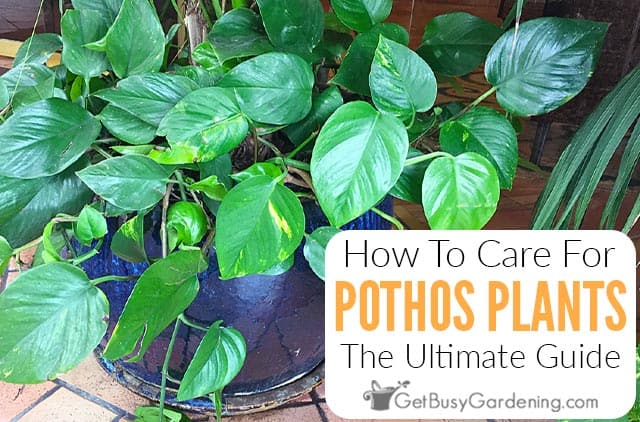
Quick Pothos Plant Care Overview
| Scientific name: | Epipremnum aureum |
| Classification: | Tropical plant |
| Common names: | Pothos, Devil’s Ivy, Devil’s Vine, Taro Vine, Money Plant |
| Hardiness: | Zones 10+ |
| Temperature: | 60-90°F |
| Flowers: | N/A |
| Light: | Partial to full shade, bright light indoors |
| Water: | Keep soil evenly moist, do not overwater |
| Humidity: | Average to high |
| Fertilizer: | General purpose plant food spring-summer |
| Soil: | Well-draining, fertile soil |
| Common pests: | Scale, mealybugs |
Information About Pothos Plants
Pothos (Epipremnum aureum) is originally from the Solomon Islands, just off the coast of Australia. In its native habitat it grows as ground cover on the forest floor. But the vines often climb up nearby trees or other taller plants, and can reach as long as 30 feet.
It’s identifiable by the waxy, heart-shaped leaves that have interesting patterned foliage. Some of the other common names you may have heard are: golden pothos, devil’s vine, devil’s ivy, and taro vine.
Sometimes people also call it a “money plant”, which can be confusing because there are several others that go by that same name. So, if you’re not here to learn about how to care for a pothos plant (Epipremnum aureum), then maybe you are looking for one of these other types of “money plants”:
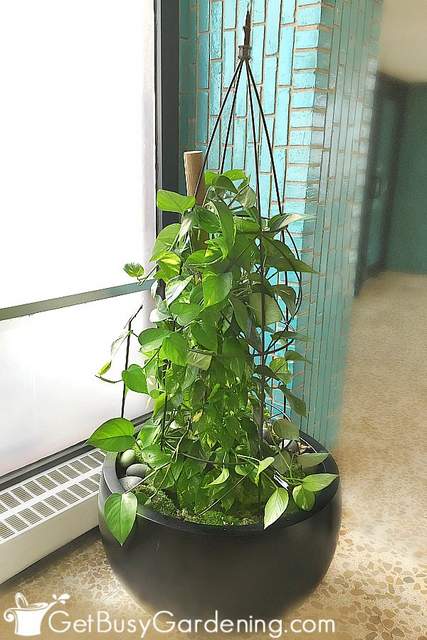
Different Types Of Pothos
There are numerous devil’s ivy varieties available. Their differences are primarily in the leaf color and the size, but the care is the same for all types. Here are a few of the most common:
- Golden Pothos – Identifiable by its speckled green and yellowish colored foliage.
- Marble Queen – Has white and green variegated leaves that look like a marbled pattern.
- Pearl & Jade – This cultivar also has variegated leaves, but they tend to be green patches in the middle with white edges.
- Neon Pothos – As the name hints, the foliage on this variety is bright neon green, which is stunning.
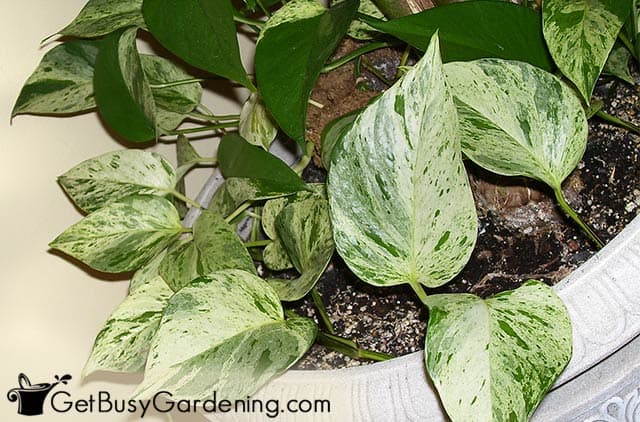
Pothos Toxicity
Unfortunately, devil’s ivy plants of every variety are toxic to cats and dogs (source: ASPCA plant list). So be very careful where you place it if you have pets or small children in your home.
How To Grow Pothos
Before diving into the details of pothos care, it’s important to understand a few basic things about growing them. Here’s how to set yourself up for the best success:
Hardiness
Though they’re most commonly sold as houseplants, pothos is actually a tender perennial in its native climate. If you live in zones 10 or higher, you can grow it outdoors year round.
They are technically hardy down to 35°F. But they do not like the cold, and will usually start to suffer once it drops below 50°F.

Where To Grow
If you live in a warm enough climate, you can grow pothos outside. They look wonderful as a ground cover in the garden, climbing a trellis, in hanging baskets, or trailing over a retaining wall.
Otherwise you’ll need to keep your devil’s ivy exclusively indoors. But they definitely benefit from spending the summer outdoors.
If you do move it outside, be sure to put it in a shady spot where it will be protected from the full sun. Then bring it back inside before the temps drop below 60°F.
Pothos Plant Care & Growing Instructions
The good news is that all types of pothos plants have the same basic care requirements. So you can follow these growing instructions no matter what variety you have.
Light
One of the reasons they makes such excellent houseplants is that devil’s ivy can thrive in a wide range of light levels. But ideally, they prefer bright, indirect sun.
All varieties can adapt to low light conditions, but they tend to lose their color or intensity of the variegation if it’s too dark.
Keep them out of the full sun though, or it will burn their tender leaves. A spot near a sunny window where they will get dappled or filtered light, or a shady location outside would be perfect.
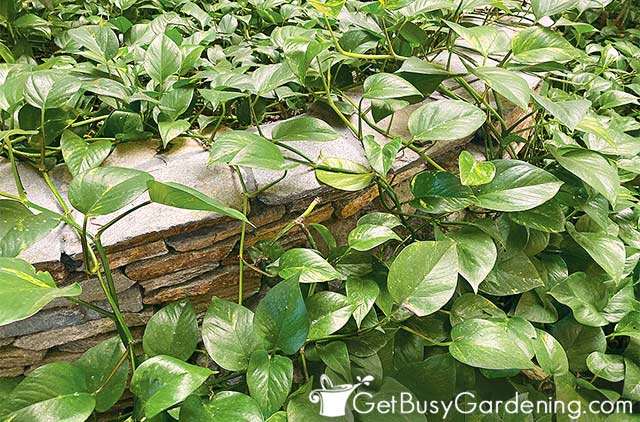
Water
Proper watering is a very important part of pothos care, and they don’t like too much. It’s best to let the soil dry out a bit between waterings, but never to the point where the plant starts wilting.
Let it dry 1-2″ deep, then give your plant a good soaking until water starts running out of the drainage holes. Dump out the excess right away, and never allow the pot to sit in water.
If you struggle with giving them the perfect amount, then get yourself an inexpensive moisture gauge to make it super easy.
Temperature
Devil’s ivy grows best in temperatures between 60-90°F. The plant will start to suffer if it gets much colder than that, and will die pretty quickly once it drops below freezing.
They can handle the heat much better, and will thrive in a warm environment. However, extremely hot and dry conditions can cause wilting. In that case, make sure to keep them well-irrigated and in the full shade.

Fertilizer
Pothos is a light feeder, so it’s not necessary to fertilize them very often. For best results, use a water-soluble fertilizer or compost tea monthly during the spring and summer.
If you prefer, you could add slow-release granules a few times during the warm months instead of using a liquid. Stop fertilizing in the late summer, and don’t feed them during the fall and winter at all.
Soil
They aren’t overly picky about the type of soil they’re growing in, so you don’t need to buy a special pothos mix for them.
However, the best type of soil is one that is rich with nutrients and drains fairly quickly. So, be sure to use a good quality potting mix for them.
If you’re someone who tends to overwater, then I recommend mixing some pumice or perlite into the soil before planting. This will add extra drainage, and help prevent overwatering.
Repotting
Another thing that makes pothos care so easy is that you don’t need to repot them very often. They can happily grow in the same container for many years.
Actually, they prefer to be pot-bound, so wait until they absolutely need it. The best time to repot is in the spring or early summer. Be sure to use a container that has drainage holes in the bottom.
Also, do not to go too big on the pot. Choose a planter that is only 1-2 sizes larger than the one it’s currently growing in.
Pruning
One of the coolest things about this beautiful plant is that it has long, vining stems. However, you must maintain them, or they can become bare and leggy over time.
This isn’t pretty, and is a common complaint I hear from newbies. So, to keep your pothos plant full and lush, you’ll need to trim the vines as a regular part of your care routine.
Pruning will trigger fresh new growth and encourage branching, resulting in a fuller plant. Once a vine starts to look bare, simply cut it off using a sharp pair of micro snips.
Pest Control
It’s not very common for pothos to have problems with bugs. However, they can occasionally become infested with mealybugs or scale, which feed on the leaves, and can cause stunted growth.
If you see evidence of bugs, treat your plant with an organic insecticidal soap or use neem oil for long-term control.
You could also try dipping a cotton ball in rubbing alcohol and wiping the underside of each leaf weekly until all evidence of the insect disappears.
Pothos Plant Propagation Tips
One of the best things about growing pothos is that they are ridiculously simple to propagate.
As I mentioned above, you should prune your devil’s ivy vines to keep them full and vigorous. Then you can place those cuttings in a vase of water to root them.
The cut-off pieces will begin to root after only a couple of weeks. Once the roots are a few inches long, you can pot them up into a container, creating a brand new plant. Get my full step by step instructions for how to propagate pothos plants here.
Troubleshooting Pothos Care Problems
The most frustrating part of pothos care is when your plant starts having problems, and you have no idea what is wrong. So in this section, I will list a few of the most common issues you may have, and give you my expert tips for how to fix them.
Yellowing Leaves Or Stems
While the most common cause is overwatering, yellow leaves or stems can also happen when they are under watered.
Always check the soil before adding more water, and never allow it to dry to the point where the plant starts drooping.
Brown Leaves, Edges, Or Spots
When the leaves or edges turn brown and crispy, that is almost always caused by under watering. But it could be sunburn, or exposure to extreme heat (like sitting next to a fireplace or heat vent).
Be sure to keep the soil evenly moist, and never let it become bone dry. Check the environment, and move the plant to a different location if necessary.
Leggy Vines With No Leaves
This is a very common problem for pothos, and happens as the vines grow longer with age. The best way to avoid (or fix) this problem is with regular pruning.
Leaves Turning Black
When the leaves suddenly turn black, that means they have been exposed to extreme cold or they froze.
This could happen when they are touching a window during the winter, are near a cold drafty window or door, or outside during freezing temperatures. Check the location, and move your plant if necessary.
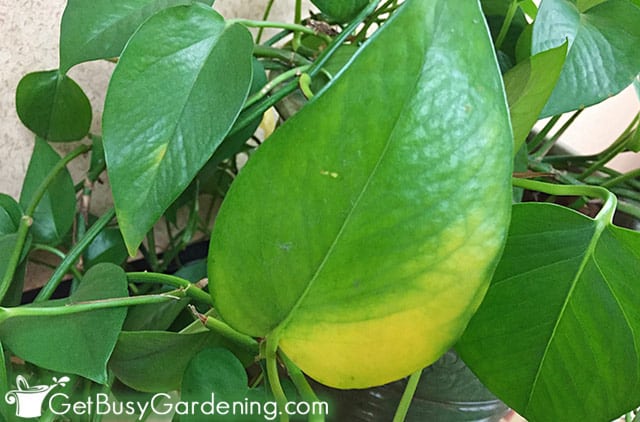
FAQs
Yes, pothos plants are extremely easy to care for, that’s how they got the common name ‘devil’s ivy’ (because they’re hard to kill). Keep them in a bright location, don’t over water, and they will be happy.
The number one cause of death for pothos plants is root rot from consistently overwatering. However, if they are neglected on a regular basis to the point where they wilt, this could also cause them to die. Other common reasons are exposure to freezing temperatures, or sitting in direct sunlight for too long.
Yes, devil’s ivy can be grown in water. But, it’s not a good practice to keep them in water long-term, or the stems could start to rot. Also, the longer they stay in water, the harder it will be for them to adapt to growing in soil again – and the shock could be fatal.
If your devil’s ivy seems to have stopped growing, it could be a couple of things. The most common reasons are lack of light, lack of nutrients (i.e.: fertilizer), or your plant is completely pot-bound. Give it bright, indirect sunlight and warm temperatures, feed it regularly, and/or repot if it’s been in the same container for a long time.
Devil’s ivy are the perfect houseplants for beginners and experts alike. Follow these pothos care instructions, and yours will flourish for a lifetime, just like mine has.
If you want to learn all there is to know about maintaining healthy indoor plants, then you need my Houseplant Care eBook. It will show you everything you need to know about how to keep every plant in your home thriving. Download your copy now!
More Houseplant Care Guides
- How To Care For A Spider Plant (Chlorophytum comosum)
- 17 Of The Best Office Plants For Your Workspace
- How To Care For A Pink Princess Philodendron
- How To Care For A Lipstick Plant
- How To Care For Bromeliads
- How To Care For Heart Leaf Philodendron (Philodendron hederaceum)
- How To Grow ZZ Plant (Zamioculcas zamiifolia)
Tell us your best pothos plant care tips in the comments section below.


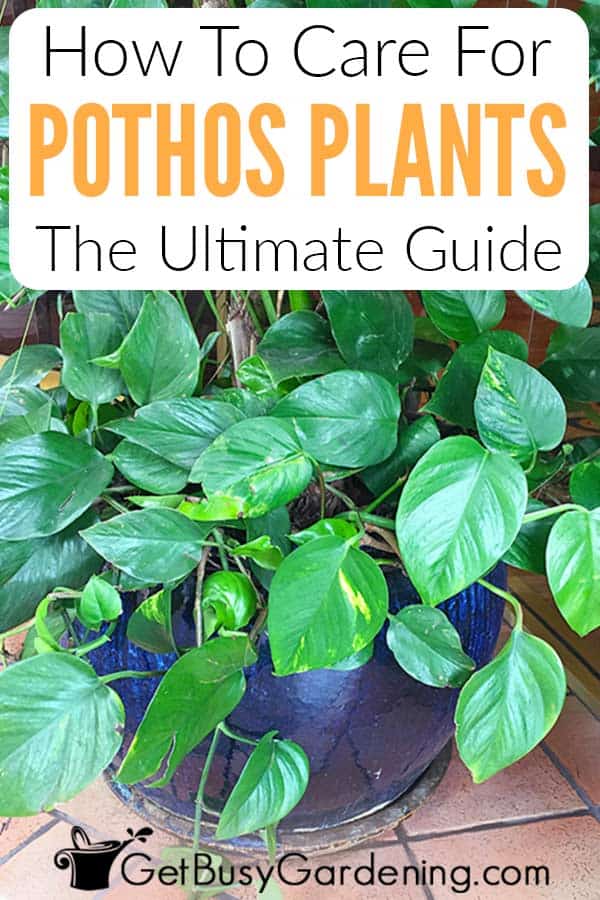


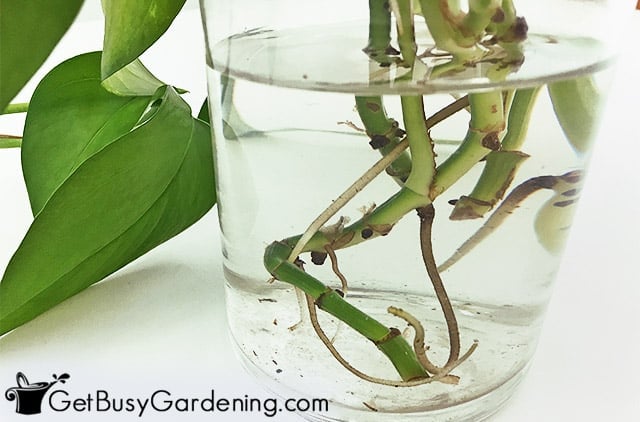


Mary says
I have a Devil’s Ivy plant and live in Manchester. Currently, all the leaves of my plant are drooping downward. It is not as vibrant as before. Some leaves are growing with black spots. Is it due to the cold weather, or is it related to air circulation and light? What could be the problem?
Amy Andrychowicz says
Oh no, I’m sorry to hear that your devil’s ivy plant is struggling. Drooping leaves and black spots could definitely be caused be cold weather. They will start to suffer if it’s below 60°F, and can’t handle any kind of freezing temps or drafts (like sitting next to a cold, drafty window, for example). If it’s in a cold location, then find a warmer spot for it.
Monica says
All the leaves on my pothos were chewed up by critters.
The plant has only bare stems now!
Can I use diluted fertilizer to encourage new growth even though is winter?
Also, I have some cuttings in water that are growing roots,
How long should I wait to plant them in the same pot with the mother plant since it has been through trauma?
Amy Andrychowicz says
Oh no, I’m so sorry to hear that your pothos plant has bugs! Definitely do not fertilize it until after you get rid of the pests, or it will put further stress on your plant – and could end up killing it. Also, if you start new cuttings, plant them in fresh soil in a clean pot. Otherwise, if you put them in the same pot, they will just get infested and eaten too. Here are tips for how to get rid of the bugs in your plant, good luck!
Teresa Pullen says
Thx for all this info. Helped me so much. I’m trying to get a green thumb. I have 2 potted devil’s ivy, indoors. Reading this, my problem with my plant is underwatering. I just ordered a tester to help me. Here’s my questions. The vines that lost all the leaves. I should prune them? Where do I cut it? Close to the soil? Can I put part of what I prune, in water to root? I have never fertilized them, in the 2years I’ve had them. What should I do to revitalize them. It’s mid November, I live in Virginia.
Amy Andrychowicz says
You’re welcome! Yes, you can prune off the empty stems all the way back to the soil level, and you can try rooting them if they’re healthy. Here’s my step by step guide for propagating pothos plants. Once you start giving your devil’s ivy the right amount of moisture, it will fill in and grow much better. Don’t fertilize it during the winter. Wait until the spring, which is the start of their active growing season.
Paul O'Donnell says
My Pothos plants is growing so gig and so fast I cannot control it.
The leaves are just huge some 500mm across.
It is inside growing up a wall.
I wish to limit it ans stop it going uo tge wall hugher than it is.
It is 4m high tge wall is 6m.
It is inside and a plasterboard wall.
The stems are 50mm diameter and have very many connections to the wall.
I wish to stop it getting higher up the wall.
Any suggestions, something I can put on it to stop the stem growing any higher..
Amy Andrychowicz says
You can prune your pothos plant as much as you need to maintain the shape and keep them at the size you want.
Zoe says
Hello!
Thanks so much foe this blog, it’s a big help!
My devils Ivy has been turning yellow since I moved house and has lost A LOT of leaves on the oldest vines (there is almost a metre without leaves from the soil on 2 of the vines). However the newer vines that were propagated last spring are healthy. I’m going to cut the longer ones and propagate, question is should I remove the stems that basically have no leaves once I’ve cut them? And also, is it possible to add the newly propagated stems to the old plant once roots have grown or is that bad for the plant in some way? And finally, is it okay for me to do this now (early January in a cold UK).
Many thanks in advance!
Amy Andrychowicz says
Yes, it’s very common for devil’s ivy to lose leaves along the vines like that. You could try propagating the pieces of the vine that don’t have leaves on them. In my experience, there’s about a 50/50 chance of them actually rooting, but it certainly doesn’t hurt to try! The best time of year for rooting the cuttings is spring or early summer once the temperatures warm up, but you could try in winter if you want. And yes, you can plant the rooted cuttings right into the same pot as the mother plant. There’s no problem there. Have fun and good luck!
Izzy says
Hi, i have mine in water and I wanted to know how long can it stay there?
Amy Andrychowicz says
Pothos cuttings can live in water for a long time – sometimes even years of you keep the water fresh. But, sometimes the stems will start to rot, so you should check on them every time you change the water. Also, the longer they stay in water, the harder the transition will be for them to grow in soil. So, you may want to pot them up as soon as they get roots, for the best success.
Frances Upton says
When my devil’s ivy has reached the top of it’s support do I just leave it to trail?
Amy Andrychowicz says
Sure, you could do that. Or you could prune your devil’s ivy to get it to branch out and grow fuller, if you want it to do that. Otherwise, just let it trail. 🙂
Magdalena says
I have a question regarding the colour on leaves of a pothos. A year ago I bought a little pothos marble queen from my neighbour (literally 4 leaves on a branch that was already rooted. The leaves had this whitish pattern but not crazy intense). I was keeping the plant on the sill of the northern window so it gets much light but not the super strong one (I have only northern and southern windows). The new leaves were growing, the plant looked (and is till this day) very healthy but the colour is gone. All the leaves are green.
What might be the reason? What can I do to stimulate the plant to produce leaves with the pattern?
Amy Andrychowicz says
Pothos plants needs tons of bright, indirect light in order to keep the variegation in the leaves. It’s very common for the leaves to turn green when they aren’t getting enough light. I would place it near your south facing window, but not directly in the sun, to give it the most light possible. Or you can try adding a grow light if you prefer.